With news that a Black Scoter
had been spotted associating amongst the raft of Common Scoter regularly seen
off Stag Rocks near Bamburgh in Northumberland during the week (it transpired
that the bird had in fact been present since the 15th Jan), we made
the decision to make the long journey up to the North East to see this vagrant American
sea duck. Only recently spilt from our Common Scoters in the last decade or so,
and with just 13 accepted records, this was a great opportunity to finally nail
this mega duck after not managing to get up for any of the previous individuals
that have graced the East coast and Scotland over the past 5 years or so and
being too young to twitch the long staying individual that resided off
Llanfairfechan back in 1999 all the way through to 2007. With birds seen off
the Northumberland coast in 2011 (in both the spring and winter) and again in
2015, it is highly likely this could be the same returning individual,
especially as the April 2011 bird was actually found off Stag Rocks.
With strong gales and rain
forecast for the Saturday however, we decided to call our journey off, thinking
it would be near impossible to locate the Black Scoter in stormy seas and
driving rain. A report at just after 11am on Saturday morning soon put paid to
that theory however, and after booking a last minute hotel 10 minutes away from
Bamburgh we were soon on our way north hoping the weather for Sunday would stay
calm and dry like predicted.
 |
| Nearby Bamburgh Castle |
Sure enough, we awoke to an
extremely calm and still morning (with Alex soon picking out an Iceland Gull
from the hotel window before we were even out on the road) and by 10am we were
on site ready to track down the Black Scoter. Being nailed down to a regular
site unlike last year’s Northumberland bird, I was hopeful we would connect and
joining 30 or so other birders overlooking the sea we were soon watching a
distant Scoter flock to the north of the rocks. Despite some of those present
convinced one individual had a much brighter bill than the others, the birds
were just far too distant to get adequate views and confirm it as the Black
Scoter.
 |
| A map of where we viewed from - our two viewing spots in red and the car park in yellow |
Moving further north up the
coastal path to a hut opposite Bamburgh Castle Golf Club to try and get better views,
the raft of Scoters came gradually nearer, although their regular diving made
staying on the same individual quite difficult. Despite this however, one bird
in a separate flock of 6 over to the right hand side started to stand out from
the rest, the bill much wider and brighter than the Common Scoters. Watching
this individual carefully as it moved slowly closer to shore with the scope on
maximum zoom, we were able to really study the finer features despite the
distance.
 |
| My dreadful record shot of our candidate for Black Scoter |
The bill was much brighter and
a darker shade of orange than the surrounding Scoters, and had a thin black
line running along the base. The bill also appeared to protrude outwards, unlike any of the surrounding Common Scoters, and there was
no obvious black on the sides of the bill, with instead a clear cut border of yellow to the fore-crown.
At one point before the Scoter dived, I also thought I saw that the colour pattern of
the bill comprised of yellow above orange (perfect for Black Scoter) although this was certainly hard to establish in the field, the majority of the time just looking one shade of orange.
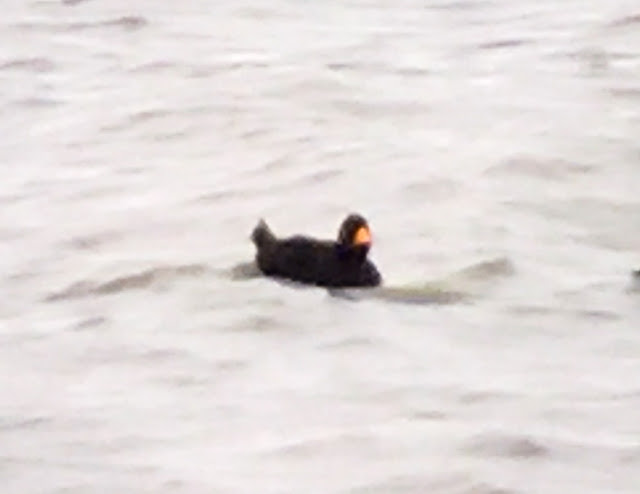 |
| The wide bill is apparent as is the bright colouration - Photo by Gareth Hughes |
Despite managing to lose sight
of this bird for around half an hour (it just seemed to vanish!) we eventually
tracked it down again and got some more record shots, again taking the time to
really study the finer features of the bill. Several Common Scoters in the
flock also had extremely bright bills (especially when facing head on), but
after careful analysis, each one of these birds had black extending up the side
of the bill and on to the nodule.
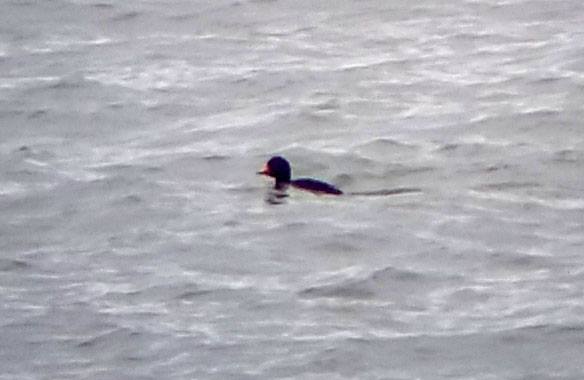 |
| Alex's photo of the bird in question - note the clear black line below the bill |
At one point, this bird and a bright billed Common Scoter both posed side-by-side head on, offering an
excellent comparison of the differences in bill structure between the two. Our bird's bill appeared a much brighter orange compared to the yellow of
this Common Scoter, as well as appearing much wider in shape due to the lack of
black up the sides of the bill – each of the Common Scoter’s bills looked like
a thin yellow strip when viewing head on.
 |
| The Common Scoters also showed bright bills at times |
However, before jumping to the conclusion that this bird must be the Black Scoter, it needs to be established that this simply isn't an aberrant Common Scoter. Something wasn't quite right when we were watching the bird, and there was never a moment when the ID was clear cut. To me, the bird didn't stand out as much as it should have done, and we were always saying "I think that's it?" having lost it in amongst the flock. Some individuals of Common Scoter can show
an abnormal amount of yellow on the bill (such as the Criccieth bird found off Wales back in 2013 and another individual recently spotted off Lleiniog) and these certainly need to be
ruled out when considering Black Scoter as an ID. This fantastic article explains more about successfully IDing Black Scoters in the field.
Looking into our photos some more and sharpening up the images to the maximum, we tried to establish if this was the case - the fact that none of our photos showed the yellow above orange that is diagnostic of Black Scoters was worrying, as was the apparent lack of a yellow globe on the bill. In all the other photos we could find showing distant Black Scoters, the pattern of yellow above orange was clear to see despite the distance involved, with their bills standing out from the other birds a great deal more than our candidate's did.
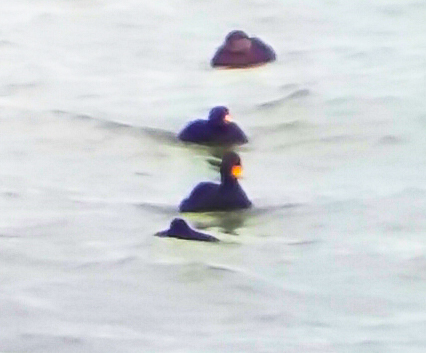 |
| Alex's photo of the Black Scoter candidate - the darker bill at the top going to paler yellow is slightly concerning |
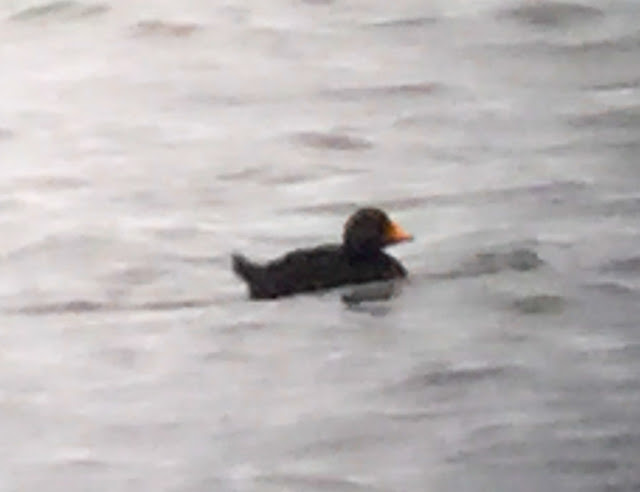 |
| I'd expect the bill to be more bulbous and showing a line of darker orange below the yellow - Photo by Gareth Hughes |
Hopefully, some more images will surface of the Bamburgh Black Scoter which shows the bill in more detail and confirming the ID, but I personally won't be adding Black Scoter to my list until such photos do so. Even though many birders watching this bird were satisfied that it was a Black Scoter, looking at our photos in further detail has cast a bit of doubt in my mind. I think it's always best to be 100% certain and know for yourself that the bird you are looking at really is what it is supposed to be!
Having lost our Black Scoter candidate once again, we admired some of the other excellent bird life in the
bay. A Slavonian Grebe constantly dived for fish over on the opposite shore,
while a Great Northern and several Red-throated Divers floated happily on the
sea. Alex managed to pick out a lone winter plumaged Puffin amongst the
Razorbills, while several pairs of Eiders drifted along on the tide. The stars
of the show though had to be the fantastic numbers of Long-tailed Ducks
present, their black and white plumage and long tails looking stunning and
definitely cementing them in my mind as one of our handsomest British ducks!
This was the first time I have seen Long-tailed Ducks in good numbers on the
sea (my first two birds were on inland water bodies) and it was also the first
time I had actually seen a male!
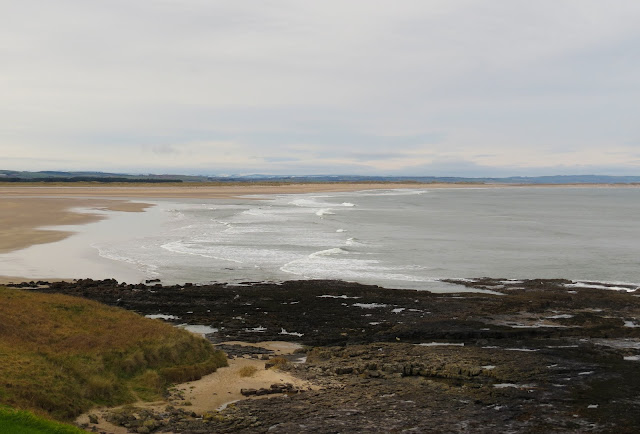 |
| Stag Rocks.... |
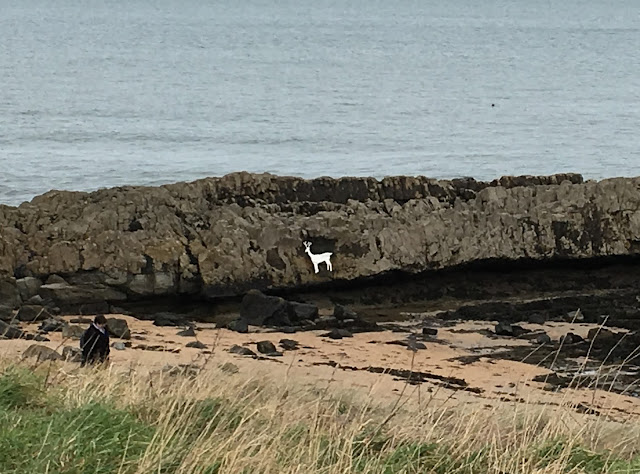 |
| ....and the Stag that gives them their name! |
With the rain now approaching
and having lost sight of the Black Scoter candidate (many of the birds had drifted further
out to sea with the receding tide) we decided to brave the 4 hour journey back
(huge thanks to Alex for driving in torrential wind and rain) and although for us the ID wasn't confirmed 100%, never the less we were happy that we had
changed our minds last minute and made the trip up to the North East for what
was a great weekend out! Hopefully more photos of the Black Scoter will surface soon, so we can really establish if the bird we saw really was what it was supposed to be!










I was at Bamburgh on Friday and had reasonably close views, also alongside the common males. We were fairly convinced. Just goes to show what a little doubt fro the right people will do.
ReplyDeleteWe've been looking closely at our own photos and have decided that it fits an aberrant Common Scoter better. I was also sent these on Saturday - an aberrant Common taken that morning at Stag Rocks and pretty sure this was our bird. That's not to say there hasn't been a Black Scoter there as well of course, but we definitely didn't see it on Sunday.
Deletehttps://twitter.com/jonathanfarooqi/status/696278554233982976